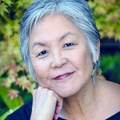There’s a haunting in Naomi Hirahara’s latest novel, Evergreen—a much-anticipated sequel to her novel, Clark and Division.
After wartime incarceration in Manzanar and then resettlement in Chicago, Aki Ito, now Nakasone, and her family have returned to Southern California, and much has changed. The haunting comes in several forms—as the voice of Aki’s deceased older sister Rose, asking not to be forgotten; as the PTSD of Aki’s 442nd veteran husband Art Nakasone; and as the material losses and livelihood of the Ito family become vividly apparent.
Hirahara’s characters are in limbo between their traumatic pasts and uncertain futures. The result is a less emotionally taut story than Clark and Division, but one richer in lesser-known stories of postwar mid-century Japanese America, reflecting the difficulties inherent in resettlement that are often glossed over. “We were so desperate to rebuild our lives that we avoided thinking about how much we had lost,” Aki reflects early in the book.
The Itos, and the newly married Nakasones, have much ground to regain. They can’t live in their old Tropico neighborhood anymore. After an all-too-brief honeymoon before Art’s 442nd stint in Europe, he and Aki must reestablish their strained young marriage. Aki’s Issei father still pines for the return of the produce market where he worked as a manager, while Aki’s mother must seek work as a house cleaner.
Aki herself is working as a nurse’s aide in the Japanese hospital—one of the few places where she can find work as a young Nisei woman without a full nursing credential. When she encounters the Issei father of Art’s best man as a patient, she becomes determined to discover the source of his injuries—and eventual death—in order to protect her marriage.
To solve this mystery she must call on her changing sense of self, her capabilities as a medical assistant, and her willingness to extend care to others outside of her family. Moreover, she must overcome her insecurities and jealousies about Art’s past as well as his budding career as an up-and-coming Nisei journalist working for the Rafu Shimpo, a welcome nod to Hirahara’s former employer.
One of the most delightful aspects of Evergreen is the cameos by Nisei lawyers and journalists of the era, who would include Elmer Yamamoto, Mary Oyama Mittmer, and Hisaye Yamamoto DeSoto.
As a fan of Yamamoto’s work, it’s a welcome surprise to read a fictional reference to her 1985 story A Fire in Fontana. In the author’s note, Hirahara says that she took the liberty of inventing these meetings, but the meetings are believable and fascinating.
The other delight is of course the meticulous historical research that Hirahara is known for in her fiction and nonfiction. She has a keen instinct for knowing what readers of post-Nisei generations are hungry for, down to the street and store names where her fictional characters travel in the neighborhoods of Boyle Heights, Little Tokyo, and Burbank.
I was also fascinated by scenes at the Winona Trailer Camp. They reveal a seedy part of resettlement that disrupts the model minority myth that some Japanese Americans carefully constructed and upheld at mid-century. Though the novel holds out a promise of peace for Aki and her family by the end, it is hard-won and ultimately tenuous, reflecting some of what we might not want to recognize: that resettlement was not an easy upward mobile path for most Japanese Americans. I’m already looking forward to the next Japantown mystery, which Hirahara says is a companion prequel to Evergreen and Clark and Division.
*This article was originally published in International Examiner on January 8, 2024.
© 2024 Tamiko Nimura






